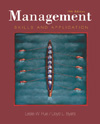 |  Management: Skills and Application, 10/e Leslie W Rue,
Georgia State University - Emeritus
Lloyd L Byars,
Georgia Institute of Technology
Appraising and Rewarding Performance
Chapter Summary1. Define performance appraisal. Performance appraisal involves determining and communicating to an employee how he or she is performing the job and establishing a plan for improvement.
2. Define performance. Performance refers to the degree of accomplishment of the tasks that make up an employee's job.
3. Explain the determinants of performance. Job performance is the net effect of an employee's effort in terms of abilities, role perceptions, and results produced. This implies that performance in a given situation can be viewed as resulting from the interrelationships among effort, abilities, role perceptions, and results produced. Effort refers to the amount of energy an employee expends in performing a job. Abilities are personal characteristics used in performing a job. Role perception refers to the direction in which employees believe they should channel their efforts on their jobs.
4. List and describe the nine major performance appraisal methods.- Evaluation by objectives involves using the objectives set in the management-by-objectives process as a basis for performance appraisal.
- The production standards approach involves setting a standard or expected level of output and then comparing each employee's performance to the standard.
- The essay appraisal method requires the manager to describe an employee's performance in written narrative form.
- The critical-incident appraisal method requires the manager to keep a written record of incidents, as they occur, involving job behaviors that illustrate both satisfactory and unsatisfactory performance by the employee being rated.
- The graphic rating scale method requires the manager to assess an individual on factors such as quantity of work, dependability, job knowledge, attendance, accuracy of work, and cooperativeness.
- The checklist method requires the manager to answer yes or no to a series of questions concerning the employee's behavior.
- The behaviorally anchored rating scale (BARS) method is designed to assess behaviors required to successfully perform a job.
- The forced-choice rating method requires the manager to rank a set of statements describing how an employee carries out the duties and responsibilities of the job.
- Ranking methods (alternation, paired comparison, and forced distribution) require the manager to compare the performance of an employee to the performance of other employees.
5. Define job analysis. Job analysis is a formal process of determining and reporting information related to the nature of a specific job.
6. Explain the contents of a job description. A job description should include the following: date written, job status, job title, supervision received, supervision exercised, job summary, detailed list of job responsibilities, principal contacts, competency or position requirements, required education or experience, and career mobility.
7. Discuss common errors made in performance appraisals. Leniency is the grouping of ratings at the positive end of the performance scale instead of spreading them throughout the scale. Central tendency occurs when performance appraisal statistics indicate that most employees are evaluated similarly as doing average or above-average work. Recency occurs when performance evaluations are based on work performed most recently.
The halo effect occurs when managers allow a single prominent characteristic of an employee to influence their judgment on each separate item in the performance appraisal.
8. Suggest ways to make performance appraisal systems more legally acceptable. Some suggestions include deriving the content of the appraisal system from job analyses; emphasizing work behaviors rather than personal traits; ensuring that the results of the appraisals are communicated to employees; ensuring that employees are allowed to give feedback during the appraisal interview; training managers in conducting proper evaluations; ensuring that appraisals are written, documented, and retained; and ensuring that personnel decisions are consistent with performance appraisals.
9. Define compensation. Compensation consists of the extrinsic rewards offered by the organization and includes the base wage or salary, any incentives or bonuses, and any benefits employees receive in exchange for their work.
10. Outline desirable preconditions for implementing a merit pay program. Desirable preconditions are trust in management; absence of performance constraints; trained managers; good measurement systems; ability to pay; a clear distinction among cost of living, seniority, and merit pay; a well-communicated total pay policy; and a flexible reward schedule. |
|



 2003 McGraw-Hill Higher Education
2003 McGraw-Hill Higher Education